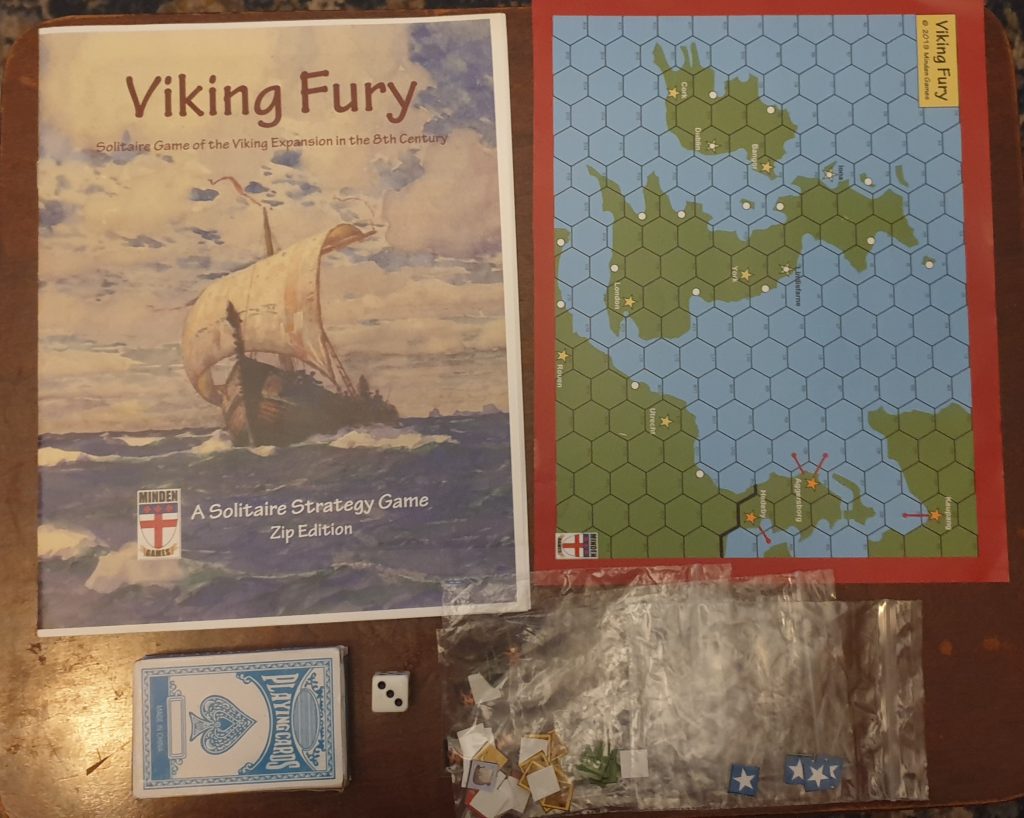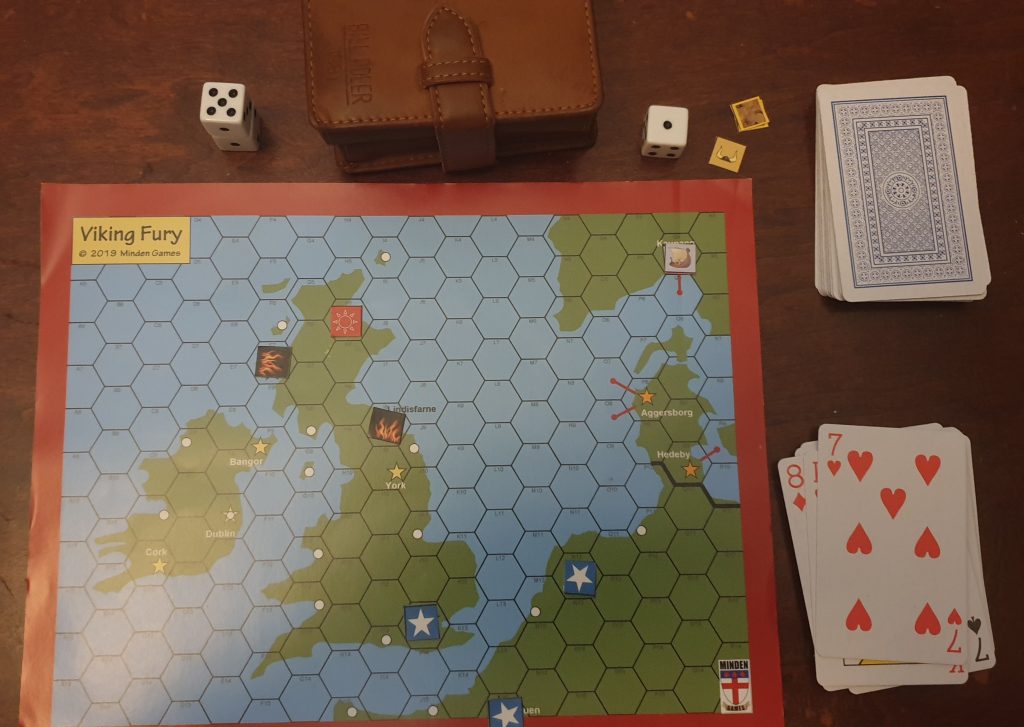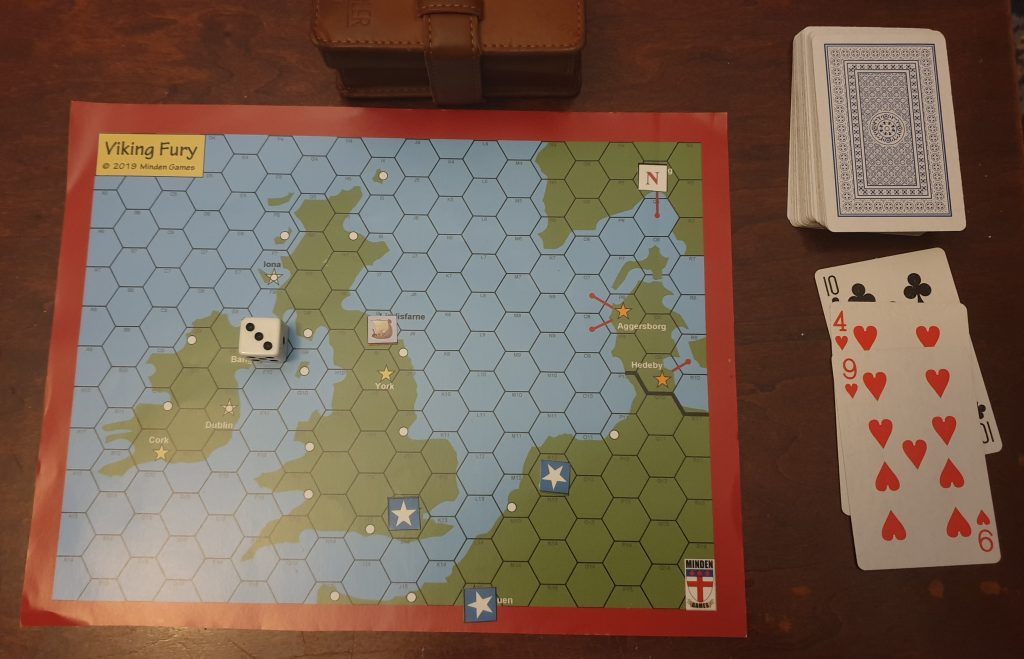It has been a Viking heavy Christmas. We have a Julbok Christmas straw goat, I’ve been catching up with the series “Vikings”, playing “Assassin’s Creed: Valhalla” and in a couple of gifts from one of my oldest friends, Dave, I got a copy of the solitaire game “Viking Fury” from Minden Games , I believe they sell it in a number of formats, but mine is the ‘zip” version.
This is a game of naughty Norse nipping across the North Sea to nick stuff. You start from your home base with at least one ship, one other advantage, a ship, a raider or better Navigation or Leadership, and you undertake three Expeditions, setting a goal of the place you want to raid, though you can raid other places if you want.

The rule book comes with a separate map, on a thicker paper than the rule book and thin, not perforated, card stock counter sheet that you need to cut out. The rule book has a copy of the map and the counters that I think you are intended to copy onto card if you have a version without the separate map and counter sheet. In any case it is a way to have spares. As well as book, map and counters you need a standard deck of cards and a normal six sided die. The small ziplock counter bags shown above were not included.
The goal you set gives you how many turns you get to mount your Expedition and each turn is divided into MOVE, CONFLICT and EVENTS. The cards are used to draw for movement and events, comparing the card drawn to a chart, the die is used when attacking locations. At the end of the three Expeditions you total up the Victory points you get for looting treasure, building settlements and if you achieve advancements in both Navigation and Leadership.
In MOVEMENT you divide up the movement points between your ships, pick up and drop off raiding parties and those raiders can also move.
If you end up on a location, you must attack it, the CONFLICT phase. That is resolved by rolling a die for the attacker and add any modifications, roll a die twice for the defender, it’s official die roll and a variable modifier, and the highest one wins. If the attacker wins then they will most likely, but not always gain treasure. The more important the settlement, the more likely it is to have a valuable, but also the better it resists attack.
The final phase is the EVENTS. A black card drawn will give a result that might be good, e.g. making a Settlement less likely to fail, or bad, e.g. cutting the number of movement cards drawn or the number of turns in an expedition or be neutral either because it does not apply or some advance you have made nullifies it.
During the Expedition, Raiding Parties can settle down and thus build Settlements, though these are vulnerable to failure. Once the Ships return to base, the Expedition is over and any treasure is banked for Victory Points. If the Expedition was successful then the player can spend that on another ship, or a raiding party or for one advance, either Leadership or Navigation.
The blue counters with white stars are strongholds. The White counter with the red N signifies the Navigation upgrade at my home port. The red lines at certain ports mean that I can only enter or exit ports though the connected hexes.
I have taken a risk, choosing the Navigation upgrade instead of an extra ship or raiding party, but this lets my ship get to Lindisfarne quickly for a traditional start to the Viking age.If my ship is destroyed though, it’s the end of the game for famed Viking ship captain and crossbowman, Bjarni the Bolt.

At the end of the first expedition, a raider was bought. This is the end of the second expedition, Iona was sacked and looted, the raiding party was dropped off in Scotland where they founded a settlement (the red counter). Flames note where Lindisfarne and Iona were. The white die on the left is how I’m recording the victory points. I made a mistake, counting the Settlement, you only do that at the end of the game in case it is destroyed.

A second ship is bought, aiming to raid two minor locations on the eastern coast of the kingdoms of the Angles and Saxons. The counters by the right hand die are the raider and treasure counters.

End of the third expedition, more fires where places used to be. The settlement survived, aided by Event cards that strengthened it. With the last two treasures retrieved, the total victory points is seven, enough to win, huzzah! It could so easily have been failure
The ship counters are in the port for the normal difficulty starting point, Kaupang. Aggersborg on the west side of Denmark is the easy starting point, Hedeby the difficult. There are other tweaks you can make to change the game, more expeditions required needing more victory points including multiple settlements, “unknown” counters so that what kind of location it is is a mystery till you get there.
This is a light game that lets you try out different strategies. Do you drop of raiding parties for settlements, go for the two ships alone and advance your techniques, risking failing to get treasure. As it is so fast and fum, you can get a few expeditions in a night, trying your ideas out.
Whilst this is a fun game, it is not a game to play night after night after night, but instead for when you have a spare hour or so and want to burn unsuspecting towns and redistribute their wealth, mostly to you. You are really going to be playing against yourself, trying ideas out and see what does well for you, maybe making things more difficult for you when you get used to it. A small footprint bit of fun that, if we ever travel again, would even be playable on a train.

